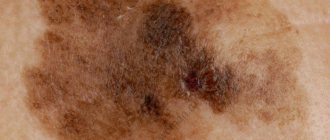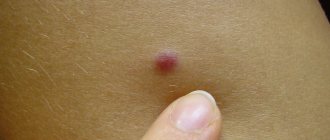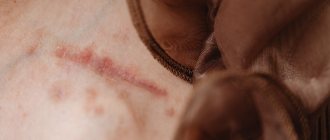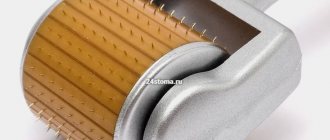A mole (birthmark) is a pigmented skin neoplasm, which extremely rarely can be congenital and appears on the skin after the baby’s first walks in the sun. In medicine, there is a more official term for moles - nevus. In their structure, color, shape and size, nevi can differ significantly from each other and are located on any part of the face and body. Nevi are mostly benign neoplasms, but under certain circumstances moles can become malignant.
Why moles appear
If we talk about the structure of a mole at the cellular level, then it consists of pigment cells of melanocytes (they produce the pigment melanin) and has an overgrown vascular network. These neoplasms are present in any person.
Among the main reasons that contribute to the formation of birthmarks are the following:
- Hereditary prerequisites;
- Prolonged exposure to the sun or artificial ultraviolet rays;
- Changes in hormonal levels (for example, pregnancy, etc.);
- Skin injuries;
- Viral skin lesions;
- Exposure to radiation.
Over the course of a person’s life, moles on the face and body may become more numerous, they may also increase in size or change their shape. In addition, under the influence of certain factors, birthmarks can degenerate into melanoma.
Treatment options
Damage to a mole does not always lead to degeneration. In this case, treatment of a birthmark comes down to eliminating the possibility of infection and quickly restoring the integrity of the integumentary tissue. After that, preventive examinations are carried out at home and with a specialist. If the decision has been made to delete, there are many options for how to do this. All of them have advantages and disadvantages, contraindications.
However, there are treatments for people who reject traditional medicine.
Attention! Remember, self-medication can harm your health!
Laser removal
Removing a disgusting birthmark with a laser is one of the main methods offered to patients. The method has become widespread due to its effectiveness.
The essence of the method:
- treatment of the pathological area and surrounding skin with an antiseptic;
- administering local anesthesia by injecting the skin around the birthmark with an anesthetic solution;
- layer-by-layer removal of tumor layers using a laser.
Advantages of the technique:
- prevention of contact infection - do not touch the wound surface with tools and hands;
- short recovery time, healthy tissues are not damaged;
- the depth and width of the effect are determined by the characteristics of the nevus;
- there is no bleeding during surgery;
- You can remove moles on the face and chest.
Negative sides:
- large formations are removed in several stages;
- temporary appearance of a dark mark at the site of the removed nevus;
- if care rules are not followed, there is a risk of infection;
- Allergy to laser irradiation is possible.
The procedure is contraindicated in the following cases:
- if a person suffers from diabetes, the disease slows down the processes of epithelial regeneration;
- there is a history of cancer;
- for any skin diseases (rashes, irritations);
- pregnancy, during which the sensitivity of the skin greatly increases.
Surgical removal
Surgery has developed a simple and common option for removing any birthmark. This method has been used for a long time and is the only one possible in the degeneration of education.
The essence of the method:
- preparation of the surgical field and local anesthesia;
- carrying out excision of the tumor within healthy tissue;
- tissue sampling for biopsy;
- suturing the wound with a cosmetic suture;
- re-treatment with an antiseptic;
- applying a bandage;
- Then dressings are carried out every day until complete healing.
Advantages:
- surgical intervention does not require high-tech equipment or instruments that require special training;
- low probability of relapse due to the widest possible excision of tissue;
- affordable price.
Flaws:
- in case of incomplete removal of a mole, there is a risk of relapse or malignant degeneration;
- duration of the recovery period – up to 2 weeks;
- if regeneration processes slow down, a keloid scar may appear;
- possibility of infection in the postoperative period;
- you need to be in a hospital hospital;
- dangerous for older people.
Contraindications:
- the presence of a focus of inflammation;
- infectious diseases;
- the presence of chronic diseases in the acute stage;
- herpes;
- pregnancy and lactation are relative contraindications.
Attention! It is not advisable to use this method during pregnancy; antibiotics are prescribed, the use of which can harm the baby. Local anesthesia is completely safe for mother and child.
Cryodestruction
The essence of the method is the use of ultra-low temperature. Liquid nitrogen is used for this. As a result of exposure to cold, inflammation appears, slight swelling occurs, a bubble forms, which then subsides and forms a crust.
There are several options for acting on fabric:
- Surface effect: achieved by applying nitrogen to fabrics, or applying cotton wool soaked in nitrogen.
- The direct effect is the introduction of nitrogen into the tissue (rarely used).
Advantages of the method:
- the method is easy to use;
- painlessness;
- the method is not invasive;
- accessible to all age groups;
- complications of the procedure are rare;
- Can be used during pregnancy and breastfeeding;
- no scars.
Flaws:
- possible damage to healthy tissue;
- the duration of complete elimination of the birthmark is up to 4 weeks;
- large formations are removed in several stages.
Contraindications:
- skin diseases;
- oncology;
- localization of the formation on the face.
Electrocoagulation
The essence of the operation:
- The surgical site is treated with an antiseptic.
- They are injected with an anesthetic.
- The pathological focus is removed using high frequency current.
- Apply a bandage.
Advantages:
- The duration of the procedure is about 30 minutes;
- no bleeding;
- scars do not appear;
- recovery time is short;
- can be used in any localization.
Flaws:
- there may be a feeling of discomfort at the venue;
- formations of a large area are not removed - a scar is formed;
- As a consequence, there is a risk of infection.
Contraindications:
- skin diseases;
- history of oncology;
- pregnancy and lactation;
- violation of the blood coagulation system.
Moles that need to be removed for preventive purposes
Moles themselves do not pose a health hazard if their structure and size do not change over time. And yet, potentially, the danger of degeneration into malignant melanoma exists if the nevus:
- often gets injured, for example, while shaving or combing, or rubs against clothes;
- rises significantly above the surface of the skin or has a long stalk;
- located in an “inconvenient place” of the body, for example, in the natural folds of the body, in the armpits, etc.;
- exposed to excessive sunlight or solariums;
- located on an area of the body that is inaccessible to the person himself.
In all of the above cases, it is better to remove birthmarks.
Features of treatment taking into account localization
Birthmarks should be removed only when indicated.
It is recommended to remove hanging papillomas on the legs and shoulders, as they are often damaged there. It is recommended to clean the head, face, and neck.
Large formations (typical of brown birthmarks) are a cosmetic defect that should be eliminated. Usually localized on the body in the face (forehead, eyes, bridge of the nose), back, and on the feet of newborns.
Blue nevus has a characteristic localization on the thigh in people 30-40 years old. It does not need to be removed if it does not cause discomfort.
Borderline, flat, red nevi should be excised if there is a cosmetic defect. Can be located anywhere on the body.
The attending physician will determine the presence of indications and contraindications for the procedure and give recommendations for the operation.
Cosmetic indications for birthmark removal
The mere presence of a mole is not a medical indication for its removal - but if the mole becomes a cause of complexes due to its poor aesthetic appearance, the doctor can remove it.
The “it’s better not to touch” principle, which many doctors used to adhere to, is already outdated. It is important to meet the following conditions:
- Carry out the removal procedure in a clinic, such as ours, with a certified experienced specialist using professional equipment;
- Make sure that the mole does not contain malignant cells. And for this, before removal, it is necessary to conduct a study - DERMATOSCOPE. In our clinic, this is a mandatory free study before removing any skin tumor!!!!
How to get rid of a birthmark at home
At home, folk methods and herbal medicines have become widespread. They are not always able to help get rid of a large birthmark, but they can affect the growth and development of small formations.
Pharmacy drugs
Stefalin: ointment based on plant materials, does not contain synthetic substances and alcohol. The composition is based on an infusion of herbs mixed with a collection ground into powder. It is important to follow the instructions for the drug. Do not wet a mole with water. It is enough to apply the drug once a day before bedtime. During the therapy, a crust will form, which can be steamed and removed independently.
Malavit: a substance based on plant components. The drug has a wide range of applications and release forms (solution, cream). Compresses are made from it at night. It is recommended to steam the application site first. Over time, the malformation will darken and dry out. After this, the procedures should be stopped.
Collomac: contains a number of acids that have a keratolytic effect and help get rid of formations by softening, after which it is easier to remove. Application period is from 3-4 days to a week. Possible side effects in the form of irritation and burning.
Cryopharm or Wartner: used to remove formations at home through cryodestruction. After freezing, the formations disappear within 10-14 days. Large or old moles may not go away the first time. Then the application should be repeated after 2 weeks.
Traditional methods
| Salicylic acid | Acid leads to gradual drying and peeling of the birthmark. During use, try not to come into contact with healthy skin. The ointment is available at any pharmacy at an affordable price. |
| Acetic acid | It is necessary to apply 1-2 drops of acid to the surface of the formation 2 times a day for a week. It is important that there is no damage to the formation itself and the skin around it. |
| Lemon acid | If it is not possible to remove a pigmented birthmark, you will be able to lighten it. The application scheme is the same as in the methods above. |
| Iodine | It has cauterizing and irritating properties due to which the mole (papilloma, nevus) will dry out and fall off. Every day, generously treat the malformation with iodine several times until the effect is achieved. |
| Laundry soap | The recipe suggests using it for 4 nights, applying a thick layer to the surface of the formation. |
| Celandine | For a cauterizing effect, it is enough to apply a cut of celandine to a wart or point, generously moistening the surface with juice. Over time, the formation will dry out and fall off. |
| Onion | Half an onion is soaked in vinegar for several hours. After this they apply the formation. |
| Oil | Castor oil is suitable for this recipe. It is heated and rubbed warm into the mole. |
Moles that need to be removed for medical reasons
It is recommended to remove moles if they:
- located in the hair area or perineum;
- have a size exceeding 5 mm;
- changed color; peeling or hardening of the surface appears;
- changed shape;
- pain, itching, burning or bleeding appeared;
- hair fell out of the nevus;
- are constantly injured (for example, while shaving);
- have a high risk of degeneration.
There are no other treatments for birthmarks other than removing them.
Removal methods
In order to remove a birthmark in our clinic, no additional tests are required. The removal procedure is carried out directly on the day of treatment if, during dermatoscopy, our doctor confirmed the benign nature of the neoplasm.
Our specialists offer almost all methods of non-surgical removal of skin tumors. However, based on our extensive experience, we recommend two main methods for effective and safe removal of nevi:
- Removal using the radio wave method using the Surgitron - DF 120 device (Ellman International Inc, USA). This device generates high-frequency radio waves. The procedure is non-contact, requires a minimum of time and can be performed without anesthesia. After removal, a barely noticeable area of hypopigmentation or a small scar may remain at the site of the mole if the formation was large.
- Removal by diathermocoagulation - plasma using the Plasmaskin device (Ultramed, Russia). In this case, the mole is exposed to very high temperatures (about 2500°C). The method is non-contact and provides a targeted effect, so surrounding tissues are not injured.
The choice of the optimal removal technique depends on the location of the tumor, its diameter and the result of dermatoscopy.
Our experts do not recommend laser removal of birthmarks due to the high risk of increased melanocyte proliferation.
If necessary, the removed mole is sent for histological examination, which will help clarify the nature of the formation. The bed of the removed tumor is treated with Fukortsin solution.
Indications for removal
Birthmarks (containing melanin pigment) or vascular elements should be removed in the following cases:
- The appearance of signs of malignancy.
- High risk of damage.
- Education is a serious cosmetic defect.
Signs of malignancy:
- sudden acceleration of growth, change in the form of education;
- education has lost its symmetry;
- the appearance of new spots of a different color (black, pink, beige);
- the boundaries of the formation have become unclear, or the smooth boundaries have become striated;
- formation of ulcers, areas of hemorrhage or bleeding;
- development of the inflammatory process, swelling appeared around the formation;
- hair loss from the surface of the nevus;
- peeling of the surface, feeling of constant itching.
If signs of degeneration appear, you should consult a doctor (dermatologist, oncologist) for advice.
He will conduct an examination, prescribe histological studies and diagnostics if necessary.
Some birthmarks on babies may disappear over time. You shouldn't panic right away.
What happens after removal
During the first day after the procedure, a dark brown crust will form at the site of the removed tumor. Healing takes from 2-3 days to 2-3 weeks, it all depends on the volume of treatment. After healing, the crust will come off on its own. Within 1-3 months, the area of skin at the site of removal will have a bright pink color, then it will acquire a normal skin color. If you follow all the doctor’s recommendations and properly care for your skin, scars will either not form at the site of removal at all, or areas of hypopigmentation or small scars may remain.
As a rule, tumors up to 7 mm in size are removed simultaneously and no additional sessions are required. If the mole is large and benign, removal can proceed in several stages in order to achieve better epithelialization and obtain an optimal cosmetic effect. In any case, after the crust is rejected, you will need to see our specialist.
The experience and highly qualified doctors of our clinic, clear diagnostics, as well as the availability of very professional equipment allow us to remove a birthmark without harm to health or any consequences. In each individual case, our specialists try to maintain a proper balance between removing the nevus in full and obtaining the best possible cosmetic effect from the procedure.
Should I remove moles on my face?
General provisions
1.1.
This Policy regarding the processing of personal data (hereinafter referred to as the Policy) is drawn up in accordance with paragraph 2 of Article 18.1 of the Federal Law “On Personal Data” No. 152-FZ of July 27, 2006, as well as other regulatory legal acts of the Russian Federation in the field of protection and processing of personal data and applies to all personal data (hereinafter referred to as the Data) that Eva LLC (hereinafter referred to as the Operator, the Company) can receive from the subject of personal data who is a user of the site (hereinafter referred to as the User) located at the address on the network Internet https://www.evamedic.ru/ (hereinafter referred to as the Site). 1.2. The operator ensures the protection of processed personal data from unauthorized access and disclosure, misuse or loss in accordance with the requirements of the Federal Law of July 27, 2006 No. 152-FZ “On Personal Data”.
1.3. Change of Policy.
1.3.1. The operator has the right to make changes to this Policy. When changes are made, the date of the last update of the edition is indicated in the title of the Policy. The new edition of the Policy comes into force from the moment it is posted on the Site, unless otherwise provided by the new edition of the Policy.
Terms and accepted abbreviations
Personal data (PD) - any information relating to a directly or indirectly identified or identifiable individual (subject of personal data).
Processing of personal data - any action (operation) or set of actions (operations) performed using automation tools or without the use of such tools with personal data, including collection, recording, systematization, accumulation, storage, clarification (updating, changing), extraction, use, transfer, depersonalization, blocking, deletion, destruction of personal data.
Automated processing of personal data - processing of personal data using computer technology.
Personal data information system (PDIS) is a set of personal data contained in databases and information technologies and technical means that ensure their processing.
Personal data made publicly available by the subject of personal data - PD, access to an unlimited number of persons is provided by the subject of personal data or at his request.
Blocking of personal data is a temporary cessation of processing of personal data (except for cases where processing is necessary to clarify personal data).
Destruction of personal data - actions as a result of which it becomes impossible to restore the content of personal data in the personal data information system and (or) as a result of which material media of personal data are destroyed.
Operator is an organization that, independently or jointly with other persons, organizes the processing of personal data, as well as determines the purposes of processing personal data to be processed, actions (operations) performed with personal data. The operator is Eva LLC, location: 654027, Kemerovo region, Novokuznetsk, st. Suvorova, house No. 6, room 45, OGRN 1144217007615, TIN 4217166873.
Processing of personal data
3.1. Receiving PD.
3.1.1. All PD should be obtained from the subject himself. If the subject's PD can only be obtained from a third party, then the subject must be notified of this or consent must be obtained from him.
3.1.2. The operator must inform the subject about the purposes, intended sources and methods of obtaining PD, the nature of the PD to be received, the list of actions with PD, the period during which the consent is valid and the procedure for its revocation, as well as the consequences of the subject’s refusal to give written consent to receive it.
3.1.3. PD is transferred by the subject for processing by the Operator by:
- visiting the Site by the User;
- filling out the feedback form on the Site by the User (request a call, leave a review, register, place an order, etc.).
3.2. PD processing.
3.2.1. Processing of personal data is carried out:
- with the consent of the subject of personal data to the processing of his personal data;
- in cases where the processing of personal data is necessary for the implementation and fulfillment of the functions, powers and responsibilities assigned by the legislation of the Russian Federation;
- in cases where the processing of personal data is carried out, access to an unlimited number of persons is provided by the subject of personal data or at his request (hereinafter referred to as personal data made publicly available by the subject of personal data).
3.2.2. Purposes of processing personal data:
- increasing awareness of Site users about the Company's products/works/services, providing relevant advertising information, optimizing advertising, providing information support, consulting, conducting marketing campaigns (including email newsletters and SMS notifications about news and promotions, etc. .), sending notifications about the status of requests, requests, orders, as well as in other cases of use of the Site by the User.
3.2.3. Categories of personal data subjects.
The PD of the following PD subjects is processed:
- individuals - Site Users.
3.2.4. PD processed by the Operator:
- last name, first name, patronymic of an individual and/or individual entrepreneur, position held, email address, contact phone number, location address;
- source of access to the Site and information from the search or advertising request;
- data about the user device (including resolution, version and other attributes characterizing the user device);
- user clicks, page views, field completions, impressions and views of banners and videos;
- data characterizing audience segments;
- session parameters;
- information about the time of visit;
- information stored in cookies
- IP address.
3.2.5. Personal data is processed:
- using automation tools;
- without the use of automation tools.
3.3. PD storage.
3.3.1. PD of subjects received by the Operator undergoes further processing and is transferred for storage in electronic form.
3.3.2. It is not allowed to store and place documents containing personal data in open electronic catalogs (file sharing services) in ISPD.
3.3.3. PD is stored in a form that makes it possible to identify the PD subject for no longer than required by the purposes of their processing, and they are subject to destruction upon achievement of the purposes of processing or in the event of the loss of the need to achieve them.
3.4. Destruction of PD.
3.4.1. PD on electronic media is destroyed by erasing or formatting the media.
3.4.2. The fact of destruction of PD is documented by an act of destruction of media.
3.5. Transfer of PD.
3.5.1. The operator transfers PD to third parties in the following cases:
- the subject has expressed his consent to such actions;
- the transfer is provided for by Russian or other applicable legislation within the framework of the procedure established by law.
Protection of personal information
4.1. The main PD protection measures used by the Operator are:
4.1.1. Appointment of a person responsible for PD processing, who organizes PD processing, training and instruction, internal control over compliance by the Operator and its employees with PD protection requirements.
4.1.2. Identification of current threats to the security of personal data when processing them in ISPD and the development of measures and measures to protect personal data.
4.1.3. Development of a policy regarding the processing of personal data.
4.1.4. Establishment of rules for access to personal data processed in ISPD.
4.1.5. Setting access passwords for the Operator's employees in the ISPD.
4.1.6. Compliance with conditions ensuring the safety of personal data and excluding unauthorized access to them.
4.1.7. Detection of facts of unauthorized access to personal data and taking measures.
4.1.8. Restoration of personal data modified or destroyed due to unauthorized access to it.
4.1.9. Training of the Operator's employees directly involved in the processing of personal data in the provisions of the legislation of the Russian Federation on personal data, including requirements for the protection of personal data, documents defining the Operator's policy regarding the processing of personal data, local regulations on the processing of personal data.
4.1.10. Implementation of internal control and audit.
Basic rights of the subject of personal data and obligations of the Operator
5.1. Basic rights of the subject of personal data.
The subject has the right to access his personal data and the following information:
- confirmation of the fact of processing of PD by the Operator;
- legal grounds and purposes of PD processing;
- the purposes and methods of PD processing used by the Operator;
- name and location of the Operator, information about persons (except for the Operator’s employees) who have access to PD or to whom PD may be disclosed on the basis of an agreement with the Operator or on the basis of federal law;
- terms of processing of personal data, including periods of their storage;
- the procedure for the exercise by the subject of personal data of the rights provided for by the Federal Law of July 27, 2006 No. 152-FZ “On Personal Data”;
- name or surname, first name, patronymic and address of the person processing PD on behalf of the Operator, if the processing has been or will be assigned to such a person;
- contacting the Operator and sending him requests;
- appealing the actions or inaction of the Operator.
5.2. Responsibilities of the Operator.
The operator is obliged:
- when collecting PD, provide information about PD processing;
- in cases where the PD was not received from the subject of the PD, notify the subject;
- in case of refusal to provide PD, the consequences of such refusal are explained to the subject;
- publish or otherwise provide unrestricted access to a document defining its policy regarding the processing of personal data, to information about the implemented requirements for the protection of personal data;
- take the necessary legal, organizational and technical measures or ensure their adoption to protect PD from unauthorized or accidental access to it, destruction, modification, blocking, copying, provision, distribution of PD, as well as from other unlawful actions in relation to PD;
- provide responses to requests and appeals from subjects of personal data, their representatives and the authorized body for the protection of the rights of subjects of personal data.
Contraindications to the removal procedure
Mole removal may not always be possible. There are a number of situations when it is better to postpone the procedure to a later time. These may be exacerbations of chronic diseases, pregnancy and breastfeeding, diseases of the cardiovascular system, etc. In the presence of other diseases and conditions, the feasibility of the procedure is determined individually.
For more information on moles, see the article “Moles - Frequently Asked Questions”








